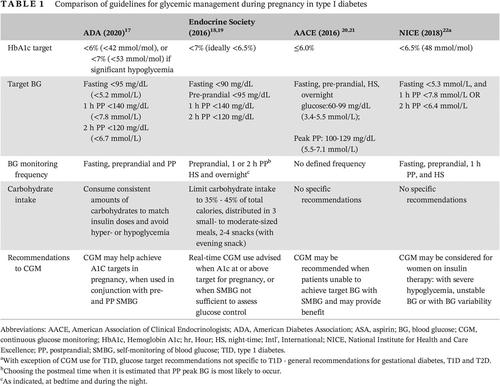当前位置:
X-MOL 学术
›
J. Diabetes
›
论文详情
Our official English website, www.x-mol.net, welcomes your
feedback! (Note: you will need to create a separate account there.)
Leveraging technology for the treatment of type 1 diabetes in pregnancy: A review of past, current, and future therapeutic tools.
Journal of Diabetes ( IF 3.0 ) Pub Date : 2020-03-20 , DOI: 10.1111/1753-0407.13030 Emily V Nosova 1 , Grenye O'Malley 1 , Eyal Dassau 2 , Carol J Levy 1
Journal of Diabetes ( IF 3.0 ) Pub Date : 2020-03-20 , DOI: 10.1111/1753-0407.13030 Emily V Nosova 1 , Grenye O'Malley 1 , Eyal Dassau 2 , Carol J Levy 1
Affiliation

|
The significant risks associated with pregnancies complicated by type 1 diabetes (T1D) were first recognized in the medical literature in the mid‐twentieth century. Stringent glycemic control with hemoglobin A1c (HbA1c) values ideally less than 6% has been shown to improve maternal and fetal outcomes. The management options for pregnant women with T1D in the modern era include a variety of technologies to support self‐care. Although self‐monitoring of blood glucose (SMBG) and multiple daily injections (MDI) are often the recommended management options during pregnancy, many people with T1D utilize a variety of different technologies, including continuous glucose monitoring (CGM), continuous subcutaneous insulin infusion (CSII), and CSII including automated delivery or suspension algorithms. These systems have yielded invaluable diagnostic and therapeutic capabilities and have the potential to benefit this understudied higher‐risk group. A recent prospective, multicenter study evaluating pregnant patients with T1D revealed that CGM significantly improves maternal glycemic parameters, is associated with fewer adverse neonatal outcomes, and minimizes burden. Outcome data for CSII, which is approved for use in pregnancy and has been utilized for several decades, remain mixed. Current evidence, although limited, for commercially available and emerging technologies for the management of T1D in pregnancy holds promise for improving patient and fetal outcomes.
中文翻译:

利用技术治疗妊娠期 1 型糖尿病:回顾过去、现在和未来的治疗工具。
20 世纪中叶,医学文献首次认识到与妊娠合并 1 型糖尿病 (T1D) 相关的重大风险。已证明血红蛋白 A1c (HbA1c) 值理想地低于 6% 的严格血糖控制可改善母婴结局。现代 T1D 孕妇的管理选择包括各种支持自我保健的技术。虽然自我血糖监测 (SMBG) 和每日多次注射 (MDI) 通常是怀孕期间推荐的管理选择,但许多 T1D 患者使用各种不同的技术,包括连续血糖监测 (CGM)、连续皮下胰岛素输注。 CSII)和CSII,包括自动传送或暂停算法。这些系统已经产生了宝贵的诊断和治疗能力,并有可能使这一研究不足的高危人群受益。最近一项评估 T1D 妊娠患者的前瞻性、多中心研究表明,CGM 显着改善了母亲的血糖参数,与较少的新生儿不良结局相关,并将负担降至最低。CSII 已获准用于妊娠期并已使用了数十年,其结果数据仍然喜忧参半。目前关于妊娠期 T1D 管理的商业化和新兴技术的证据虽然有限,但有望改善患者和胎儿的结局。评估 T1D 妊娠患者的多中心研究表明,CGM 显着改善了母亲的血糖参数,与较少的新生儿不良结局相关,并将负担降至最低。CSII 已获准用于妊娠期并已使用了数十年,其结果数据仍然喜忧参半。目前关于妊娠期 T1D 管理的商业化和新兴技术的证据虽然有限,但有望改善患者和胎儿的结局。评估 T1D 妊娠患者的多中心研究表明,CGM 显着改善了母亲的血糖参数,与较少的新生儿不良结局相关,并将负担降至最低。CSII 已获准用于妊娠期并已使用了数十年,其结果数据仍然喜忧参半。目前关于妊娠期 T1D 管理的商业化和新兴技术的证据虽然有限,但有望改善患者和胎儿的结局。
更新日期:2020-03-20
中文翻译:

利用技术治疗妊娠期 1 型糖尿病:回顾过去、现在和未来的治疗工具。
20 世纪中叶,医学文献首次认识到与妊娠合并 1 型糖尿病 (T1D) 相关的重大风险。已证明血红蛋白 A1c (HbA1c) 值理想地低于 6% 的严格血糖控制可改善母婴结局。现代 T1D 孕妇的管理选择包括各种支持自我保健的技术。虽然自我血糖监测 (SMBG) 和每日多次注射 (MDI) 通常是怀孕期间推荐的管理选择,但许多 T1D 患者使用各种不同的技术,包括连续血糖监测 (CGM)、连续皮下胰岛素输注。 CSII)和CSII,包括自动传送或暂停算法。这些系统已经产生了宝贵的诊断和治疗能力,并有可能使这一研究不足的高危人群受益。最近一项评估 T1D 妊娠患者的前瞻性、多中心研究表明,CGM 显着改善了母亲的血糖参数,与较少的新生儿不良结局相关,并将负担降至最低。CSII 已获准用于妊娠期并已使用了数十年,其结果数据仍然喜忧参半。目前关于妊娠期 T1D 管理的商业化和新兴技术的证据虽然有限,但有望改善患者和胎儿的结局。评估 T1D 妊娠患者的多中心研究表明,CGM 显着改善了母亲的血糖参数,与较少的新生儿不良结局相关,并将负担降至最低。CSII 已获准用于妊娠期并已使用了数十年,其结果数据仍然喜忧参半。目前关于妊娠期 T1D 管理的商业化和新兴技术的证据虽然有限,但有望改善患者和胎儿的结局。评估 T1D 妊娠患者的多中心研究表明,CGM 显着改善了母亲的血糖参数,与较少的新生儿不良结局相关,并将负担降至最低。CSII 已获准用于妊娠期并已使用了数十年,其结果数据仍然喜忧参半。目前关于妊娠期 T1D 管理的商业化和新兴技术的证据虽然有限,但有望改善患者和胎儿的结局。











































 京公网安备 11010802027423号
京公网安备 11010802027423号